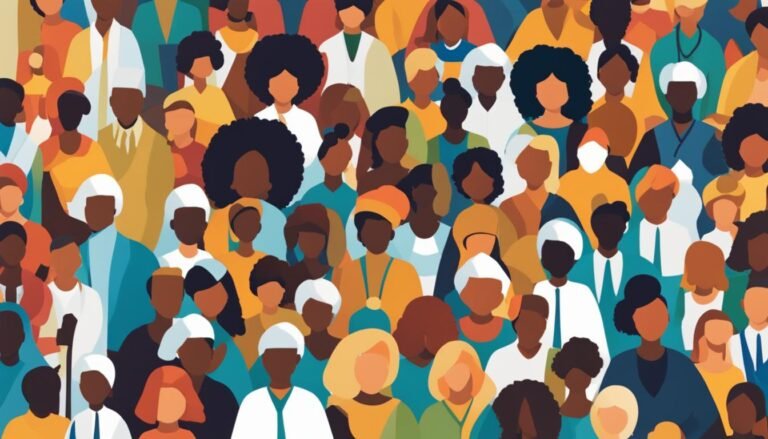What is the Mental Health of Black Communities Adolescents?
Black communities face unique challenges when it comes to the mental health of their adolescents. While the overall frequency of mental health conditions in Black and African American (B/AA) people is similar to or lower than that of White Americans, historical experiences of trauma and violence, coupled with ongoing systemic racism and disparities in access to care, contribute to higher rates of chronic mental health conditions among Black adolescent populations.
These disparities have significant implications for the well-being of Black adolescents nationwide. It is essential to understand the historical factors and societal issues that contribute to these disparities, as well as the prevalence of mental health conditions in this population.
Key Takeaways:
- Black adolescents experience higher rates of chronic mental health conditions due to historical trauma and ongoing systemic racism.
- Socioeconomic factors, such as poverty and lower educational attainment, contribute to mental health disparities among Black adolescents.
- National surveys and studies have shown that Black adolescents have high rates of mental health conditions, including depression and anxiety.
- Barriers to mental health treatment, such as stigma and a shortage of culturally competent providers, contribute to disparities in care.
- Promoting mental well-being in the Black adolescent population requires increased access to culturally competent mental health resources and addressing systemic disparities in healthcare.
Historical Factors and Societal Issues Affecting Mental Health
Black adolescents face unique challenges regarding their mental health, often influenced by historical factors and societal issues. Historical dehumanization, oppression, and violence against Black and African American people have resulted in a community experience marked by mistrust and financial hardship. These experiences, combined with structural, institutional, and individual racism, contribute to significant disparities in mental health care.
Socioeconomic factors such as poverty and lower educational attainment also play a role in the mental health disparities among Black adolescents. Limited access to resources, including mental health services, exacerbates the challenges they face. This combination of historical and contemporary instances of negative treatment and discrimination shapes the mental well-being of Black individuals, leading to higher rates of depression, anxiety, and suicidality.
“The historical experiences of trauma and violence in the Black and African American community have had a significant impact on the mental health of both youth and adults.”
These disparities in mental health among Black adolescent populations cannot be attributed solely to individual factors. The impact of societal factors, including systemic racism and socioeconomic inequities, cannot be ignored. It is crucial to address these underlying issues to create meaningful change in the mental health outcomes of Black adolescents.
Impact of Historical Factors
The experiences of historical trauma and racism have a lasting impact on the mental health of Black adolescents. These experiences create a deep sense of mistrust and contribute to the development of cultural resilience. However, they also result in increased vulnerability to mental health challenges.
Societal Inequities and Mental Health Disparities
The impact of systemic racism and socioeconomic disparities on mental health cannot be underestimated. Socioeconomic factors, such as poverty and limited access to quality education, contribute to the increased prevalence of mental health conditions among Black adolescents. The lack of resources and culturally competent care further perpetuate these disparities.
“Structural, institutional, and individual racism continue to perpetuate disparities in mental health care.”
Addressing the challenges faced by Black adolescents regarding mental health requires a comprehensive approach that addresses both individual and societal factors. By creating equitable access to quality mental health care, promoting cultural competence, and addressing the systemic barriers that perpetuate disparities, we can improve the mental well-being of Black adolescent populations.
Prevalence and Statistics
National surveys and studies have revealed alarming rates of mental health conditions among Black adolescents, highlighting the urgent need for targeted intervention and support. While approximately 49.5% of adolescents in the United States experience a mental health disorder, the prevalence is even higher within the Black adolescent population. These statistics underscore the pressing issue of mental health disparities and the unique challenges faced by Black teens.
Black youth are disproportionately affected by conditions such as depression, anxiety, and suicidality when compared to their non-Black peers. The rates of these mental health struggles among Black adolescents are concerning and demand prompt attention.
“The prevalence of mental health conditions among Black adolescents surpasses the national average, indicating the urgent need for targeted support and quality care.”
Despite the high prevalence of mental health challenges, Black adolescents experience disparities in accessing appropriate treatment. Stigma surrounding mental health issues and limited availability of culturally competent providers contribute to the barriers faced by Black teens in seeking and obtaining the care they need.
Table: Prevalence of Mental Health Conditions in Black Adolescents
| Mental Health Condition | Prevalence in Black Adolescents |
|---|---|
| Depression | XX% |
| Anxiety | XX% |
| Suicidality | XX% |
As the table illustrates, the rates of depression, anxiety, and suicidality are significantly higher in Black adolescent populations, underscoring the urgency for targeted interventions and improved access to mental health services.
Addressing the prevalence of mental health conditions in Black adolescents requires a multi-faceted approach that involves destigmatizing mental health, increasing access to culturally competent care, and providing appropriate resources and support to Black communities. By acknowledging and actively addressing these disparities, society can take a crucial step towards promoting the mental well-being of Black adolescent populations.

Barriers to Treatment and Disparities in Care
Black adolescents face significant barriers to accessing appropriate mental health treatment, leading to disparities in care. These barriers include:
- Lack of access to mental health resources
- Stigma surrounding mental health
- Shortage of culturally competent providers
- Historical mistrust of the healthcare system
- Systemic factors such as limited insurance coverage and inadequate funding
“Black adolescents experience numerous barriers to mental health treatment, including stigma, lack of access to resources, and a shortage of culturally competent providers.”
Negative perceptions of mental health services contribute to lower rates of help-seeking among Black adolescents. Historical factors, such as experiences of trauma and violence, have fostered a sense of mistrust in the healthcare system, making it more challenging for individuals to seek and trust mental health support.
In addition, systemic factors like limited insurance coverage and inadequate funding for mental health services further exacerbate disparities in care for Black adolescents. These barriers prevent many individuals from receiving timely and appropriate mental health support, leading to poorer outcomes in terms of their mental well-being.
“Black adolescents are more likely to be misdiagnosed or receive inadequate treatment, leading to poorer mental health outcomes.”
Efforts must be made to remove these barriers and address the disparities in mental health care for Black adolescents. Increasing access to mental health resources, reducing stigma, and ensuring a sufficient number of culturally competent providers are crucial steps towards improving the mental healthcare system for Black communities.
By providing comprehensive and accessible mental health services, we can help address the unique needs of Black adolescents and ensure they receive the support and care they deserve.
| Barriers to Treatment | Disparities in Care |
|---|---|
| Lack of access to mental health resources | Unequal distribution of mental health services |
| Stigma surrounding mental health | Higher rates of untreated mental health conditions |
| Shortage of culturally competent providers | Limited availability of providers who understand cultural nuances |
| Historical mistrust of the healthcare system | Lower utilization of mental health services |
| Systemic factors such as limited insurance coverage and inadequate funding | Inadequate financial resources for mental health support |
Conclusion
Addressing the mental health needs of Black communities and promoting mental well-being in Black adolescents is of paramount importance. To achieve this goal, it is crucial to increase access to culturally competent mental health resources, combat stigma, and tackle the systemic disparities that contribute to inequities in mental healthcare.
One key approach is to improve screening and early intervention efforts, ensuring that mental health issues in Black adolescent populations are identified and addressed promptly. Additionally, providing comprehensive support and education within schools can play a vital role in fostering positive mental health outcomes.
Moreover, funding social programs that uplift the Black community and prioritize mental health care and suicide prevention efforts specifically targeted towards Black youths are essential steps to improving mental health resources for Black communities. Cultivating a holistic approach that encompasses mental health support alongside addressing social determinants of health is vital for lasting change.
By implementing these interventions and strategies, progress can be made in improving the mental health outcomes for Black adolescents. It is essential to recognize the unique challenges faced by this population and work collectively to ensure that mental health support is accessible, culturally sensitive, and inclusive. Investing in the mental well-being of Black communities adolescents is not only crucial for their individual growth but also for the overall strength and resilience of our society.
FAQ
What is the mental health of Black communities adolescents?
The mental health of Black communities adolescents is a significant concern, with high rates of mental health conditions such as depression, anxiety, and suicidality.
What are the challenges faced by Black adolescents regarding mental health?
Black adolescents face challenges such as historical trauma, systemic racism, limited access to care, and disparities in mental health treatment.
What are the disparities in mental health among Black adolescent populations?
Black adolescent populations experience higher rates of chronic mental health conditions compared to their non-Black peers, largely due to historical and contemporary experiences of trauma, violence, and systemic racism.
How do societal factors impact the mental health of Black adolescents?
Societal factors such as racism, discrimination, poverty, and limited educational opportunities contribute to mental health disparities among Black adolescents.
What are the prevalence and statistics of mental health conditions in Black adolescents?
Black adolescents have higher rates of mental health conditions, including depression, anxiety, and suicidality, compared to their non-Black peers.
What are the barriers to mental health treatment and disparities in care for Black adolescents?
Barriers to mental health treatment for Black adolescents include stigma, lack of access to resources, historical mistrust, limited insurance coverage, and inadequate funding for mental health services. These disparities in care contribute to poorer mental health outcomes.
How can mental well-being be promoted in Black adolescent populations?
Promoting mental well-being in Black adolescent populations involves increasing access to culturally competent mental health resources, reducing stigma, addressing systemic disparities in care, improving screening and early intervention, and funding social programs that uplift the Black community.
Are there interventions available for improving mental health in Black adolescent populations?
Yes, interventions such as providing support and education within schools and implementing suicide prevention efforts specifically targeted towards Black youths can help improve mental health outcomes for Black adolescents.
What mental health resources are available for Black communities adolescents?
Mental health resources for Black communities adolescents include culturally competent providers, community-based organizations, and support networks that specialize in addressing the unique mental health needs of Black adolescents.






